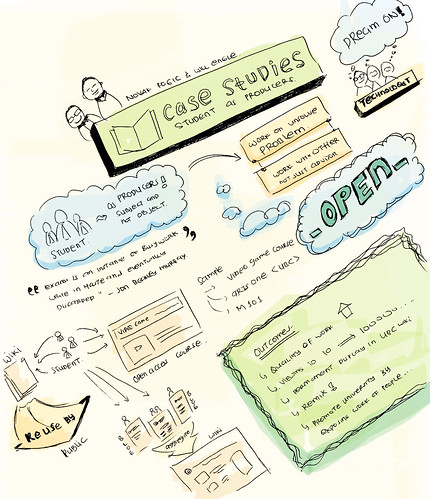“In the end, an essay or an exam is an instance of busywork: usually written in haste; for one particular reader, the professor; and thereafter discarded.” – Jon Beasley-Murray, from Was introducing Wikipedia to the classroom an act of madness leading only to mayhem if not murder?
Novak and I recently had the opportunity to present at ETUG’s Fall Workshop on the topic of “Case Studies for Students as Producers.” In the Student as Producer model, as Derek Bruff has eloquently distilled from Mike Neary’s conceptualization: “students should move from being the object of the educational process to its subject. Students should not be merely consumers of knowledge but producers, engaged in meaningful, generative work alongside the university’s faculty”.
This idea of positioning student work as as a collaborative and valuable resource alongside that of faculty members is an important driver of uptake for some the tools and technologies, such as UBC Blogs and the UBC Wiki, that support open education initiatives. Here are a couple of the amazing open projects working using these tools to support students as producers:
- Some instructors in the Arts One program are asking their students to critique or analyze readings and lectures on blogs. The use of blogs takes the writings out of a closed loop with only the instructor reading and responding to a student’s work. Instead, the students are sharing their critiques and thoughts openly on the internet, where they are contributing to the scholarly conversation of classic texts of the past two millennia. Furthermore, the student blog posts are syndicated via rss to the Arts One Open site, where the student content appears along side the instructor content, creating a rich and robust extension of the course. Clicking on any given tag, such as Borges, gives amazing and growing archive of online lectures, podcasts, essays, and critiques. Finally, since the students are blogging on their own personal blogs, they control their content, which they can delete, edit, or move to a new space at will.
- Similarly, in LAW423B: Video Game Law, students can author directly on the public facing course website, allowing them to create and post content along side the instructor. This content is not just limited to the student and instructor, but is on an open website that is quickly becoming a highly trafficked and widely-read resource about a specific topic. Thus, students are sharing their work and being read by leaders in the video game law community.
- Students in FNH200 are asked to author collaborative open wiki and video projects, thus students are not only sharing their work with instructor, each other, and, well, the world, but also future students who will take the course. This is important because, as it turns out, current and past students are setting the bar for the quality of future projects. The quality of the student work is being elevated as students are able to review and reference previous years projects, build upon them, and develop what is effectively an open knowledge base on food science (and their work is being incorporated into he course).
And here’s our slides for our presentation:
We broke pretty much every rule there is about using slides effectively in a presentation (bad design, low colour contrast, mismatched fonts on walls of text, etc) but I’m going to position that strategy as intentional effort to highlight the artistry of the projects we’ve been fortunate to witness and support in one way or another.
